







A set of CG56 demonstration programs have been developed. A top-level palette, shown in figure
15-12, contains an icon for each demo palette.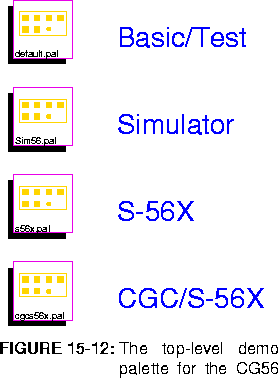 The demos are grouped by the CG56 target on which they are implemented. If you do not have the require compiler, simulator, or DSP card, then you can still run the demos to see the generated code. To do this make sure that the run and compile target parameters are to NO. By default, the generated code is written to
The demos are grouped by the CG56 target on which they are implemented. If you do not have the require compiler, simulator, or DSP card, then you can still run the demos to see the generated code. To do this make sure that the run and compile target parameters are to NO. By default, the generated code is written to
$HOME/PTOLEMY_SYSTEMS directory.
The Basic/Test palette contains six demonstrations (figure
15-13).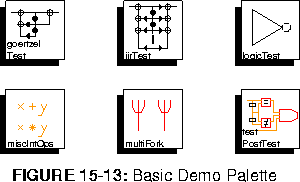
goertzelTest Test the Goertzel filters for computing the discrete Fourier transform.
iirTest Test the infinite impulse response (IIR) filters.
logicTest Test various comparison tests and Boolean functions.
miscIntOps Test integer arithmetic operations.
multiFork Test the AnyAsmFork star. An AnyAsmFork star is one of a group of stars that do produce any code at compile time.
testPostTest Test the DTMFPostTest star used in touchtone decoding.
The demos in palette figure
15-14 will generate stand alone applications.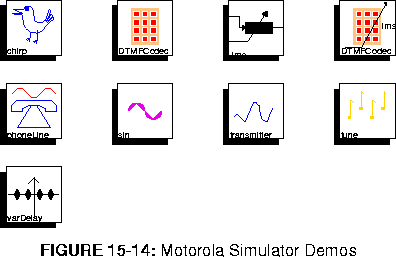 These applications will consist of: a shell script to control the simulator and output display programs; a simulator command file; and the assembled code to run on the simulator. The simulator can be run in either an interactive mode or in the background by setting the interactive target parameter.
These applications will consist of: a shell script to control the simulator and output display programs; a simulator command file; and the assembled code to run on the simulator. The simulator can be run in either an interactive mode or in the background by setting the interactive target parameter.
chirp This system uses two integrators and a cosine to generate a chirp signal.
DTMFCodec Demonstration of touchtone detection using the discrete Fourier transform implemented by using Goertzel filters.
lms A noise source is connected to an eighth-order least-mean squares (LMS) adaptive filter with initial taps specifying a lowpass filter. The taps adapt to a null filter (the impulse response is an impulse) and the error signal is displayed.
lmsDTMFCodec Demonstration of touchtone detection using Normalized Direct Frequency Estimation implemented by using Least-Mean Squares (LMS) adaptive filters.
phoneLine A telephone channel simulator. A tone is passed through some processing which implements various distortions on a telephone channel. The parameters that are controllable are: noise, channel filter, second harmonic, third harmonic, frequency offset, phase jitter frequency, and phase jitter amplitude.
sin A sine wave is generated by using two integrators in a feedback loop.
transmitter A simple 4-level PAM transmitter
tune A tune is generate using FM synthesis of notes stored in a table. The sounds produced are not particularly musically appealing, partly because the modulation index is not variable and the attack and decay profiles are too limited.
varDelay This is a simple application demonstrating variable delay with linear interpolation.
The demos shown in figure
15-15 require an Ariel S-56X DSP board to be installed in the workstation.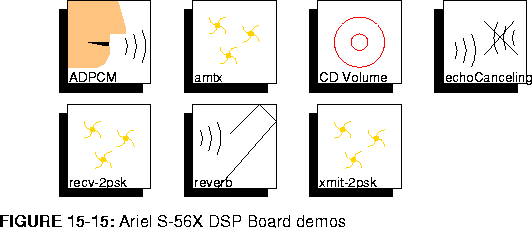 In addition, all but the first demo requires QDM. These demos generate a stand alone application consisting of: a shell script to download and run the assembled code; a file specifying the asynchronous user I/O interface; and the assembled code.
In addition, all but the first demo requires QDM. These demos generate a stand alone application consisting of: a shell script to download and run the assembled code; a file specifying the asynchronous user I/O interface; and the assembled code.
ADPCM This demo implements a ADPCM coder and decoder. The user at run time can vary the number of quantization bits, the quantization range, and a delay so that signal can be heard instantaneously or a second later. Requires an Ariel Proport and a microphone.
amtx Amplitude Modulation Transmitter. The results of the transmitter are displayed asynchronously at run time.
CD Volume A universe showing a implementing a volume control with CG56HostSliderGX stars. Requires a modified CD player.
echoCanceling A system implementing a pair of echo cancellation filters. The first echo cancellation filter cancels an artificial echo introduced by an FIR filter. The second echo cancellation filter is used to cancel the echoes produced by have one microphone next to loud speaker. Another microphone is used for desired input, such as speech. Requires an Ariel Proport and two microphones.
recv-2psk 2-PSK Bandpass filter.
reverb This system implements a reverberation system using Comb filters. Requires an Ariel Proport and a microphone.
xmit-2psk 2-PSK transmitter.
All of the demos in this palette use the CompileCGSubsystems target described in section
13.4 on page 13-10.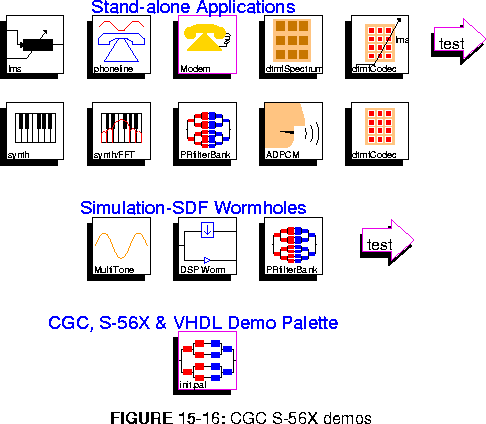
The first set demos generate stand alone applications consisting of two parts: a program generate in C that implements the sub-graph that runs on the host, and a program generated in Motorola 56k assembly that is to be run on the S-56X. The C program initializes and downloads the S-56X program automatically. The first two of the demos shown in figure
15-16, lms, phoneLine, DTMFCodec and lmsDTMFCodec are identical to the simulator demos.
Modem The modem palette contain 3 phased shift keying modem demos. These demos illustrate the use of peek/poke actors and hierarchical scheduling. Requires an Ariel Proport and a microphone.
dtmfSpectrum This demos implements a DTMF tone generator and displays the resultant frequency spectrum.
synth A FM music synthesis demonstration. Requires an Ariel Proport.
synthFFT A FM music synthesis demonstration showing the resultant frequency spectrum. Requires an Ariel Proport.
PRfilterBank A perfect reconstruction filter bank.
ADPCM This demo implements a ADPCM coder and decoder. The user at run time can vary the number of quantization bits, the quantization range, and a delay so that signal can be heard instantaneously or a second later. Requires an Ariel Proport and a microphone.
The simulation SDF wormhole demos create simulation SDF stars in ptlang and also a load file for the S-56X card. Unlike the other CG56 demos, the applications produced here will not run as stand alone applications. The wormhole allows the user to imbed a CG56 system running on a Ariel S-56X DSP board into a Ptolemy simulation.
MultiTone Generates three sine waves on the S-56X which are at different rates relative to one another.
DSPWorm Demonstrates multirate I/O between Ptolemy and the S-56X board.
PRfilterBank A perfect reconstruction filter bank.
The demos in this palette all implement some for of a perfect reconstruction filter bank.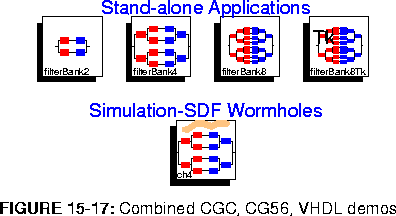 One of the examples generates a simulation SDF star which makes use of a VHDL simulator, the S-56X DSP card and the workstation.
One of the examples generates a simulation SDF star which makes use of a VHDL simulator, the S-56X DSP card and the workstation.








Copyright © 1990-1997, University of California. All rights
reserved.






















